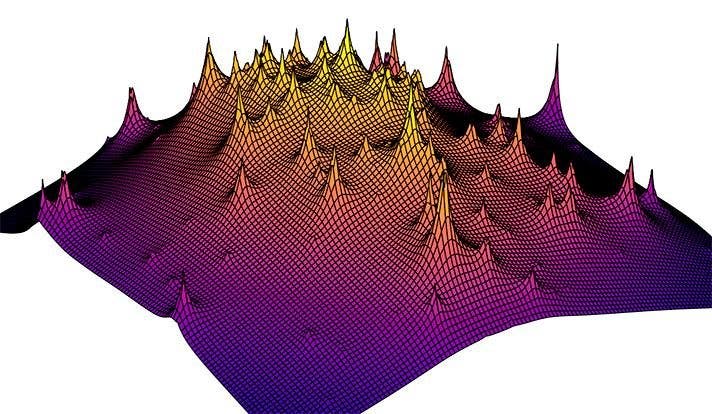Yale researchers have created one of the most accurate maps of dark matter, helping us uncover the secrets of the universe.

This is a 3-D visualization of reconstructed dark matter clump distributions in a distant galaxy cluster, obtained from the Hubble Space Telescope Frontier Fields data. The unseen matter in this map is comprised of a smooth heap of dark matter on which clumps form. We don’t know why the clumps for or what they mean. Credit: Yale University
Whenever we’re looking at the Universe, we’re mostly blind. According to our current understanding, the universe is roughly 27 percent dark matter, 68 percent dark energy and about 5 percent ordinary matter. We’ve seen quite a bit of the 5% matter… but that’s still just 5%. The rest of the 95% remains hidden to our sight.
Take dark matter for instance. It’s an unidentified type of matter which does not emit or interact with electromagnetic radiation (such as light). Therefore, we can’t really see it. We know it exists somehow because we see its gravitational effects — including something called gravitational lensing.
A gravity lens is a phenomenon observed when a distribution of matter (such as a cluster of galaxies) lies between an observer (the Earth) and a distance light source. As the light travels from the source to the observer, it bends when it gets close to the cluster of galaxies. By studying the shapes and orientations of large numbers of distant galaxies, their orientations can be averaged to measure the shear of the lensing field in any region. This, in turn, can be used to reconstruct the mass distribution in the area: in particular, the background distribution of dark matter can be reconstructed.
“With the data of these three lensing clusters we have successfully mapped the granularity of dark matter within the clusters in exquisite detail,” Natarajan said. “We have mapped all of the clumps of dark matter that the data permit us to detect, and have produced the most detailed topological map of the dark matter landscape to date.”
So basically, they see the lensing and see the regular mass around it — the rest of the lensing, the one that can’t be explained by regular matter, indicates the presence of the dark matter. Do this several times, in several directions, and you’d end up with a map of dark matter.
“While we now have a precise cosmic inventory for the amount of dark matter and how it is distributed in the universe, the particle itself remains elusive,” Natarajan said.
What’s remarkable is that this map closely resembles previous computer simulations, indicating that astronomers have a pretty good idea of what’s going on. The fact that with only indirect evidence, astronomers have predicted dark matter with such accuracy is impressive — and it’s also a testament to how much the field has advanced in recent years.
Journal Reference: Priyamvada Natarajan, Urmila Chadayammuri, Mathilde Jauzac, Johan Richard, Jean-Paul Kneib, Harald Ebeling, Fangzhou Jiang, Frank van den Bosch, Marceau Limousin, Eric Jullo, Hakim Atek, Annalisa Pillepich, Cristina Popa, Federico Marinacci, Lars Hernquist, Massimo Meneghetti, Mark Vogelsberger. Mapping substructure in the HST Frontier Fields cluster lenses and in cosmological simulations. Monthly Notices of the Royal Astronomical Society, 2017; DOI: 10.1093/mnras/stw3385









